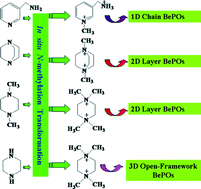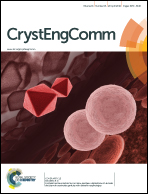Series of crystalline beryllium phosphates including new templates generated by in situ N-methylation transformation†
Abstract
Four new organically templated beryllium phosphates, [Hmampy][Be(HPO4)2] (1), [dmdabco][Be3(HPO4)4]·(H2O)1.5 (2), [tmpip][Be(HPO4)(H2PO4)]2 (3) and [tmpip][Be2(HPO4)2(H2PO4)]2 (4), where Hmampy = monoprotonated N-methyl-3-(aminomethyl) pyridinium), dmdabco = N,N′-dimethyl-1,4- diazabicyclo[2,2,2]octane and tmpip = N,N,N′,N′-tetramethyl-piperazinium, were hydrothermally synthesized involving in situ generation of structure-directing agents. The Hmampy2+, dmdabco2+ and tmpip2+ templates were in situ generated by methylation of organic cyclic amines: 3-(aminomethyl)pyridine (ampy) in 1, 1,4-diazabicyclo[2,2,2]octane (dabco) in 2, 1,4-dimethyl-piperazine (dmpip) in 3 and piperazine (pip) in 4. This methylation is different from the conventional Eschweiler–Clarke reaction in which an excess of formic acid and formaldehyde is required. Compound 1 contains infinite inorganic chains which are linked by the organic templates in helical hydrogen-bondings, and 2 and 3 possess different layers with eight- and twelve-membered apertures, respectively. Compound 4 has a three-dimensional interrupted open-framework which is constructed from two-dimensional sheets pillared by phosphate nodes, forming intersecting 8-, 10- and 12-ring channels.


 Please wait while we load your content...
Please wait while we load your content...